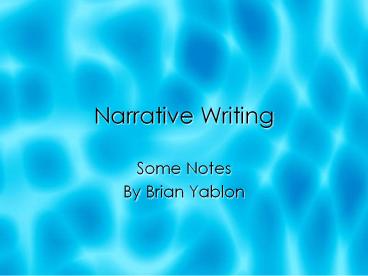Narrative Writing - PowerPoint PPT Presentation
Title:
Narrative Writing
Description:
Narrative Writing Some Notes By Brian Yablon What is Narration? Narration means telling a story, or a series of stories for a purpose. The Communication Connection ... – PowerPoint PPT presentation
Number of Views:128
Avg rating:3.0/5.0
Title: Narrative Writing
1
Narrative Writing
- Some Notes
- By Brian Yablon
2
What is Narration?
- Narration means telling a story, or a series of
stories for a purpose.
3
The Communication Connection
- There are always three parts to communication
- The creator (writer, songwriter, playwright,
photographer, sculptor, painter, etc.) - The creation (text, song, sculpture, play, movie,
etc.) - The receiver (reader, listener, viewer)
4
How They Fit Together
- The creator (writer) manipulates the creation
(text) in order to influence, or cause the
desired reaction from, the receiver (the reader). - So, if you want to make someone laugh, write a
funny story. - If you want someone to feel, create an emotional
song, etc.
5
What Can Narratives Do?
- Help persuade readers by telling a compelling
story. - Help define an idea by telling an exemplary
story. - Show similarities or differences with
comparison-contrast.
- Help show effects or causes by sharing a dramatic
account of events or situations. - Entertain.
- Inform by telling what happened.
6
What to do First?
- Decide upon a purpose -- what effect do you want
to have on the reader? - Decide on an audience -- to whom are you telling
your story?
7
Figure out the Obstacles
- All stories have one or more of the following
- Crisis
- Conflict
- Obstacle
- Decision
- problem
8
Types of Conflicts
- Internal conflicts
- Decisions that characters need to make
9
Other types of conflicts
- External conflicts
- Character versus character, such as two people
competing for a job or in an argument - Character versus something LARGE, such as
society, God, nature, tradition
10
Figure out the Setting
- Settings include
- Time (of day, week,, month, season, year, decade,
century, era)
11
Location, Location, Location
- Location (a spot, in a room, in a house, on a
block, in a neighborhood, in a city, in a state,
in a country, on a planet)
12
Think about Events
- Narratives focus on actions.
- Decide on which actions you will focus in order
to achieve your desired effect.
13
Create Interesting Characters
- Readers care about characters more than any other
part of a story. - Make them interesting and memorable.
14
Consider Perspective
- There are three choices of narrative perspective
to embrace - First person
- Second person
- Third person
15
First Person Point of View
- When using first person point of view, the
narrator tells his/her story and uses I, and
me as the narrative stance. - The narrator is part of the story and telling it
from his/her perspective.
16
Second Person Point of View
- Here, the narrator is directly interacting with
the reader, and uses the word you as the
narrative stance. - This is used almost exclusively when giving
instructions.
17
Third Person Point of View
- Here, the narrator is observing the story and is
not part of it. - He/she uses words such as he, she, they,
them, and it.
18
Types of Third Person P.O.V.
- Omniscient
- The narrator knows the actions, thoughts, and
feelings of all the characters. - Limited Omniscient
- The narrator knows only the thoughts and feelings
of a single character but may know the actions of
all other characters.
19
More on Perspectives
- Once you choose a narrative perspective, stick
with it -- switching back and forth between
perspectives almost always confuses the reader.
20
Consider organization
- Make your narrative clear and easy to follow.
21
Chronological
- This is the most common way to organize your
story. - Beginning, middle, end.
- Morning, noon, night.
- Monday, Tuesday, Wednesday, etc.
- This is simple and straightforward.
22
Flashbacks
- In a flashback, the story starts in the middle of
the action. - Then, the narrator recounts images, or memories,
of the past -- to explain how the characters got
to their present state of affairs.
23
Flash-Forwards
- A flash-forward is a variation on a flashback.
- The story begins almost at the end of the action,
then retraces the steps leading to that point,
then finishes up the story.
24
Dont confuse the Reader
- Remember, you can be complicated, but you must
always be clear to your reader. - If your reader cannot follow your story, then the
story is worthless.
25
So What?
- Always write a story that has meaning for you.
- Butyou need to convey the importance of your
story to your reader. - Story-telling is a shared experience.
26
Be aware of Language.
- Your choice of words creates a tone.
- Be aware of the tone you create and the words you
choose to use to create it.
27
The Grammar Police
- Make sure that you avoid errors.
- You want readers to pay attention to your story,
not the annoying errors made in telling that
story.
28
Good Words
- Always use vivid, concrete, specific, interesting
words. - Get rid of lifeless words that dont really say
anything.
29
Use Dialogue
- Its always interesting to hear people speak,
even if theyre only speaking to themselves. - Always try to include dialogue.
30
So, take a seat and relax
31
And lets tell a story































